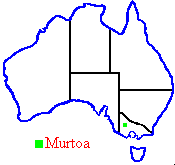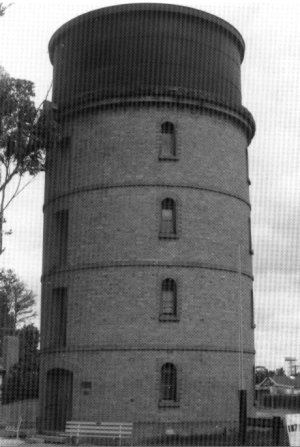1872. The Land
Act of 1869 opened up the country around Lake Marma for free selectors. The first wheat
crops were sown this winter and around Christmas, taken off by hand sickle. What wasn't
kept for seed was sent by wagon to Stawell, the wagons were usually back loaded with
building materials. Churches were established, the first Lutherans met at Gustav
Degenhardt's home. 1873. Originally
called Marma Gully, after the first survey by T. H. Breen. The name had Aboriginal
origins, either meaning 'Home of the Wild Duck' or, after an old black 'King Marma', who
lived with his family at Marma Swamp, 4 km east of the Lake Marma. The township was
renamed Murtoa in 1873 by Walter Madden, the Land Officer in Horsham. It was planned that
the Lake would be in the centre of the town. Murtoa is an Aboriginal name meaning 'Home of
the Lizard'. On the 17th of August a new building in Marma Street was completed which
served as a combined Church, School and Town Hall. It was constructed of bulloak saplings
pugged with mud. It had a thatched roof of straw and an earthen floor.
1874. The Commercial Hotel was built.
Over the next decade, many more hotels were built at Murtoa, including the - Bull &
Mouth, Club, Colonial, Murtoa, Railway, Shamrock and Victoria. [ The Commercial Hotel was
rebuilt in its present form about 1911 and renamed the Marma Gully in 1977 ]
1875. J. H. Martin UHE and J. Heinrich
SCHULZ were among the 25 foundation members of St John's Lutheran Church. The resident
Pastor was C. G. Hiller.
1876. William C. Thomas opened a Flour
Mill near the Lake.
Mr. Thomas built a bigger flour mill near the railway line after it
was extended to Horsham on the 5th of February 1879.
1877. The Commercial Bank opened a branch
at Murtoa on the 6th of February. [ The State Savings Bank arrived in 1912 ] Murtoa's
first Policeman was Mounted Constable Gray, who arrived on the 18th of June. On the 1st of
May, the Education Department took over the running of the school in Murtoa. On the 31st
of August, the lease expired on the old school in Marma Street. Lessons began on the 3rd
of September at the new Primary School (No 1549) on the present site in Duncan Street.
Higher Elementary School lessons began in February 1922. Classes
were held in the Fire Brigade Hall and in the Methodist & Presbyterian Sunday Schools,
until the brick Higher Elementary School opened in March 1925. Murtoa High School was
proclaimed on the 4th of February 1956.
1878. The first edition of the Dunmunkle
Standard hit the streets of Murtoa on the 6th of December at a cost of 6 pence. After the
17th of December, when the railway line came through from Stawell, most development was on
the East of the lake toward the railway line. The Murtoa Brass Band first performed in
1878. [ Coromby Brass Band was formed in 1891 ]
1879. Horse Racing came to Murtoa around
1879.
1880. Murtoa Urban Fire Brigade was
organised. In later years, some of the Uhe boys played an active part. [ A Bush Fire
Brigade was formed on the 20th of December 1915 to fight rural fires ]
1881. The Murtoa Agricultural and
Pastoral Society was formed on the 9th of April with a meeting at the Court House. The
first 'Show' was held on Thursday the 18th of August.
1882. An Angling Club was formed, members
stocked Lake Marma with Tench & other fish, and later built a pier from which to fish.
Marma Lodge (No 84) was also formed in 1882.
1883. On the 29th of March at a meeting
in the Court House, the Murtoa Branch (No 22) of the Australian Natives Association was
formed. J. H. Martin UHE's son, F. C. August Uhe was president 1899-1900 and was later a
trustee.
1884. On the 20th of March, to cater for
the 640 inhabitants of Murtoa a proper Post Office was opened for business at the corner
of Marma and McDonald Streets. Prior to this, mail came via a hotel at Longerenong, Mr. J.
B. Millar's farm, then Anderson's store in Barkly (later called Duncan) Street.
A new Post Office was built in McDonald Street in 1959.

